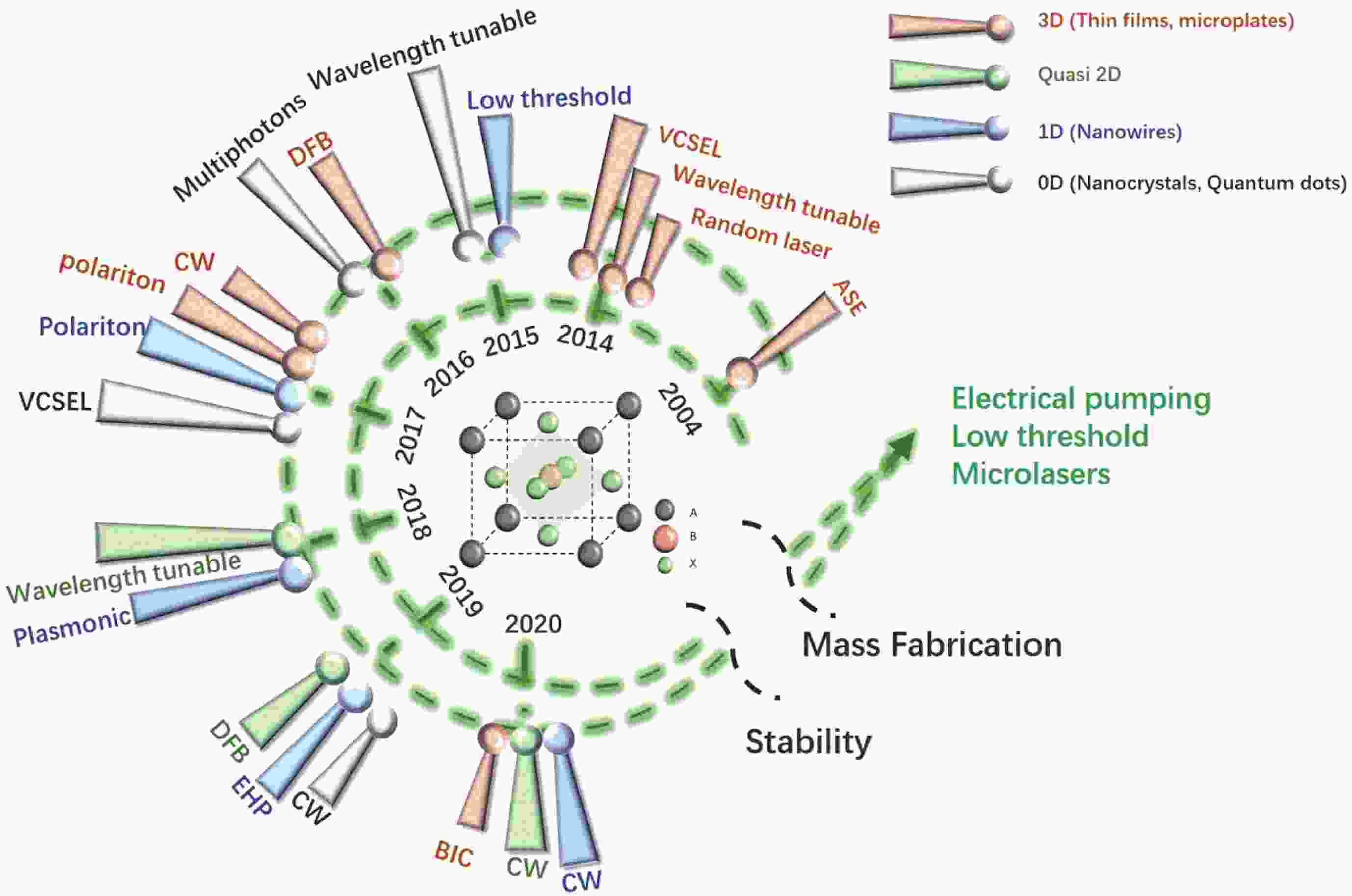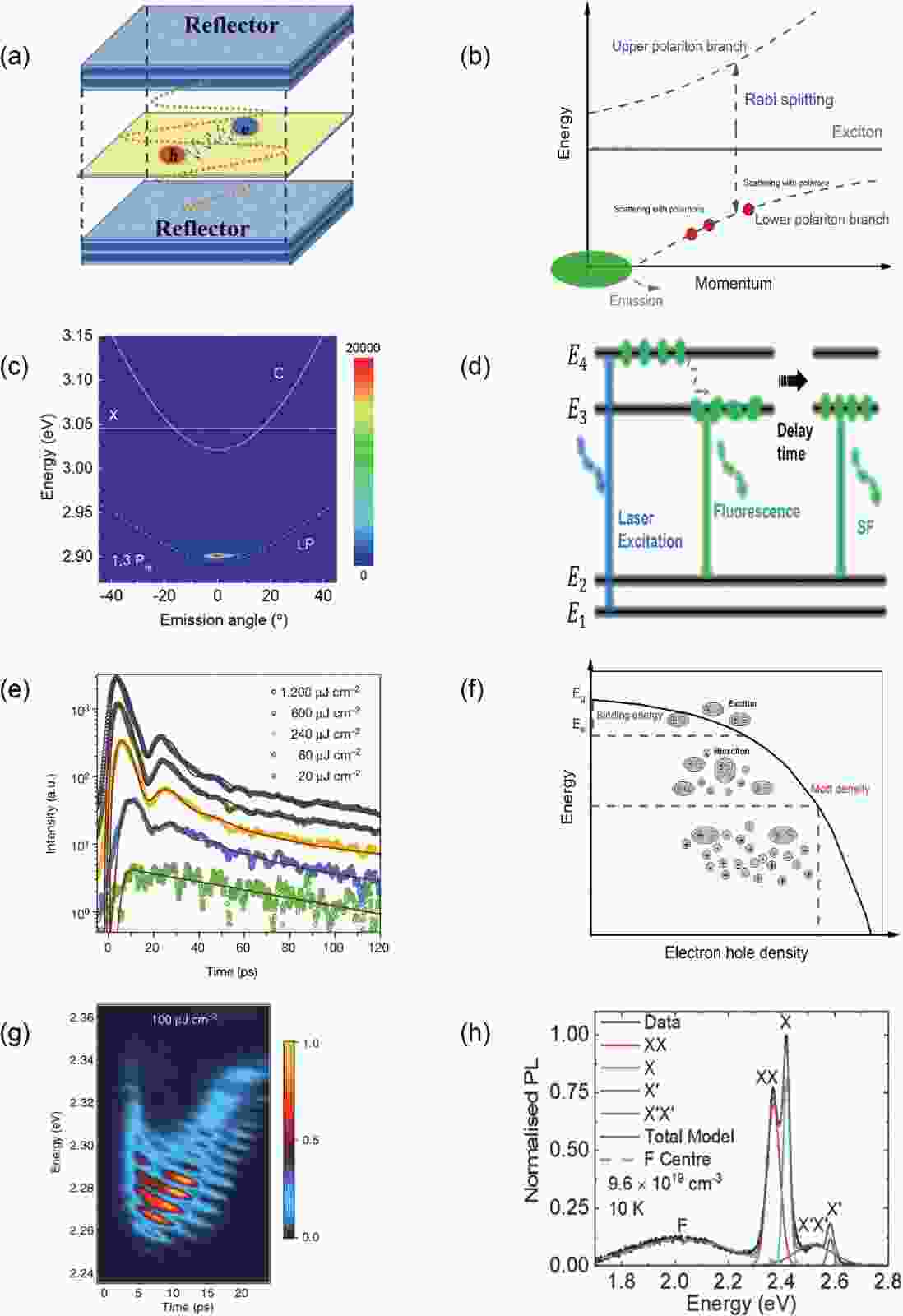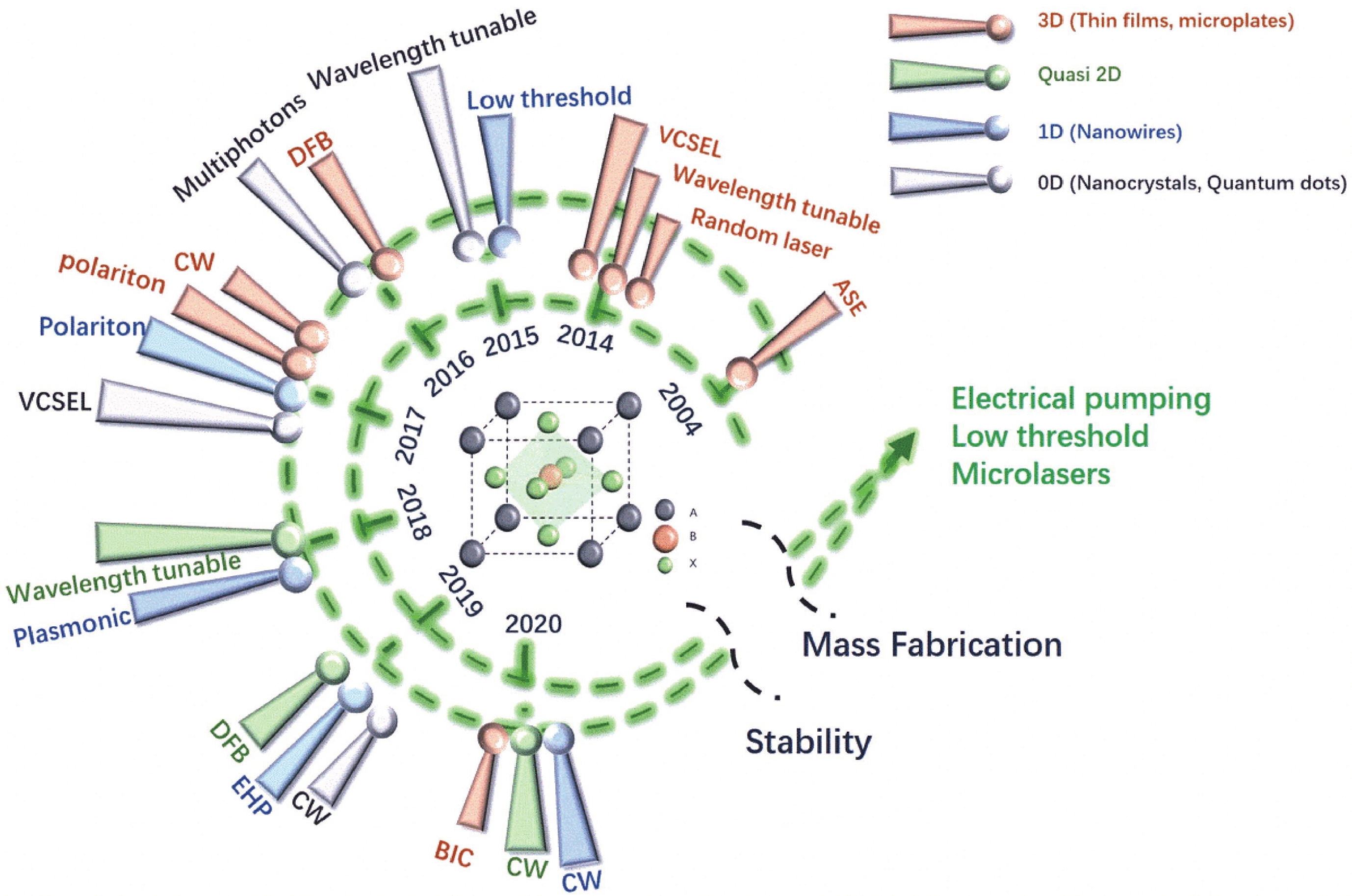| Citation: |
Ju Wang, Shufeng Wang, Liming Ding. The physical origin of stimulated emission in perovskites[J]. Journal of Semiconductors, 2022, 43(5): 050202. doi: 10.1088/1674-4926/43/5/050202
J Wang, S F Wang, L M Ding. The physical origin of stimulated emission in perovskites[J]. J. Semicond, 2022, 43(5): 050202. doi: 10.1088/1674-4926/43/5/050202
Export: BibTex EndNote
|
The physical origin of stimulated emission in perovskites
doi: 10.1088/1674-4926/43/5/050202
More Information-
References
[1] Zhang Q, Shang Q, Su R, et al. Halide perovskite semiconductor lasers: materials, cavity design, and low threshold. Nano Lett, 2021, 21, 1903 doi: 10.1021/acs.nanolett.0c03593[2] Kondo S, Suzuki K, Saito T, et al. Photoluminescence and stimulated emission from microcrystalline CsPbCl3 films prepared by amorphous-to-crystalline transformation. Phys Rev B, 2004, 70, 2469 doi: 10.1103/PhysRevB.70.205322[3] Xing G, Mathews N, Lim S S, et al. Low-temperature solution-processed wavelength-tunable perovskites for lasing. Nat Mater, 2014, 13, 476 doi: 10.1038/nmat3911[4] Dhanker R, Brigeman A N, Larsen A V, et al. Random lasing in organo-lead halide perovskite microcrystal networks. Appl Phys Lett, 2014, 105, 151112 doi: 10.1063/1.4898703[5] Zhu H, Fu Y, Meng F, et al. Lead halide perovskite nanowire lasers with low lasing thresholds and high quality factors. Nat Mater, 2015, 14, 636 doi: 10.1038/nmat4271[6] Wang Y, Li X, Zhao X, et al. Nonlinear absorption and low-threshold multiphoton pumped stimulated emission from all-inorganic perovskite nanocrystals. Nano Lett, 2016, 16, 448 doi: 10.1021/acs.nanolett.5b04110[7] Jia Y, Kerner R A, Grede A J, et al. Continuous-wave lasing in an organic-inorganic lead halide perovskite semiconductor. Nat Photonics, 2017, 11, 784 doi: 10.1038/s41566-017-0047-6[8] Li M, Gao Q, Liu P, et al. Amplified spontaneous emission based on 2D Ruddlesden-Popper perovskites. Adv Funct Mater, 2018, 28, 1707006 doi: 10.1002/adfm.201707006[9] Li M, Wei Q, Muduli S K, et al. Enhanced exciton and photon confinement in Ruddlesden-Popper perovskite microplatelets for highly stable low-threshold polarized lasing. Adv Mater, 2018, 30, 1707235 doi: 10.1002/adma.201707235[10] Huang C, Zhang C, Xiao S, et al. Ultrafast control of vortex microlasers. Science, 2020, 367, 1018 doi: 10.1126/science.aba4597[11] Qin C, Sandanayaka A S D, Zhao C, et al. Stable room-temperature continuous-wave lasing in quasi-2D perovskite films. Nature, 2020, 585, 53 doi: 10.1038/s41586-020-2621-1[12] Jia Y, Kerner R A, Grede A J, et al. Factors that limit continuous-wave lasing in hybrid perovskite semiconductors. Adv Opt Mater, 2020, 8, 1901514 doi: 10.1002/adom.201901514[13] Wang W, Li Y, Wang X, et al. Density-dependent dynamical coexistence of excitons and free carriers in the organolead perovskite CH3NH3PbI3. Phys Rev B, 2016, 94, 140302 doi: 10.1103/PhysRevB.94.140302[14] Su R, Diederichs C, Wang J, et al. Room-temperature polariton lasing in all-inorganic perovskite nanoplatelets. Nano Lett, 2017, 17, 3982 doi: 10.1021/acs.nanolett.7b01956[15] Rainò G, Becker M A, Bodnarchuk M I, et al. Superfluorescence from lead halide perovskite quantum dot superlattices. Nature, 2018, 563, 671 doi: 10.1038/s41586-018-0683-0[16] Schlaus A P, Spencer M S, Miyata K, et al. How lasing happens in CsPbBr3 perovskite nanowires. Nat Commun, 2019, 10, 265 doi: 10.1038/s41467-018-07972-7[17] Booker E P, Price M B, Budden P J, et al. Vertical cavity biexciton lasing in 2D dodecylammonium lead iodide perovskites. Adv Opt Mater, 2018, 6, 1800616 doi: 10.1002/adom.201800616[18] Du W, Zhang S, Zhang Q, et al. Recent progress of strong exciton-photon coupling in lead halide perovskites. Adv Mater, 2019, 31, 1804894 doi: 10.1002/adma.201804894[19] Kasprzak J, Richard M, Kundermann S, et al. Bose-Einstein condensation of exciton polaritons. Nature, 2006, 443, 409 doi: 10.1038/nature05131[20] Guillet T, Brimont C. Polariton condensates at room temperature. C R Phys, 2016, 17, 946 doi: 10.1016/j.crhy.2016.07.002[21] Deng H, Haug H, Yamamoto Y. Exciton-polariton Bose-Einstein condensation. Rev Mod Phys, 2010, 82, 1489 doi: 10.1103/RevModPhys.82.1489[22] Bouteyre P, Nguyen H S, Lauret J S, et al. Room-temperature cavity polaritons with 3D hybrid perovskite: toward large-surface polaritonic devices. ACS Photonics, 2019, 6, 1804 doi: 10.1021/acsphotonics.9b00625[23] Evans T J S, Schlaus A, Fu Y, et al. Continuous-wave lasing in cesium lead bromide perovskite nanowires. Adv Opt Mater, 2018, 6, 1700982 doi: 10.1002/adom.201700982[24] Bao W, Liu X, Xue F, et al. Observation of Rydberg exciton polaritons and their condensate in a perovskite cavity. Proc Natl Acad Sci USA, 2019, 116, 20274 doi: 10.1073/pnas.1909948116[25] Zhang S, Chen J, Shi J, et al. Trapped exciton–polariton condensate by spatial confinement in a perovskite microcavity. ACS Photonics, 2020, 7, 327 doi: 10.1021/acsphotonics.9b01240[26] Su R, Ghosh S, Liew T C H, et al. Optical switching of topological phase in a perovskite polariton lattice. Sci Adv, 2021, 7, eabf8049 doi: 10.1126/sciadv.abf8049[27] Feng J, Wang J, Fieramosca A, et al. All-optical switching based on interacting exciton polaritons in self-assembled perovskite microwires. Sci Adv, 2021, 7, eabj6627 doi: 10.1126/sciadv.abj6627[28] Su R, Fieramosca A, Zhang Q, et al. Perovskite semiconductors for room-temperature exciton-polaritonics. Nat Mater, 2021, 20, 1315 doi: 10.1038/s41563-021-01035-x[29] Bonifacio R, Lugiato L A. Cooperative radiation processes in two-level systems: Superfluorescence. Phys Rev A, 1975, 11, 1507 doi: 10.1103/PhysRevA.11.1507[30] Malcuit M S, Maki J J, Simkin D J, et al. Transition from superfluorescence to amplified spontaneous emission. Phys Rev Lett, 1987, 59, 1189 doi: 10.1103/PhysRevLett.59.1189[31] Findik G, Biliroglu M, Seyitliyev D, et al. High-temperature superfluorescence in methyl ammonium lead iodide. Nat Photonics, 2021, 15, 676 doi: 10.1038/s41566-021-00830-x[32] Mattiotti F, Kuno M, Borgonovi F, et al. Thermal decoherence of superradiance in lead halide perovskite nanocrystal superlattices. Nano Lett, 2020, 20, 7382 doi: 10.1021/acs.nanolett.0c02784[33] Eaton S W, Lai M, Gibson N A, et al. Lasing in robust cesium lead halide perovskite nanowires. Proc Natl Acad Sci USA, 2016, 113, 1993 doi: 10.1073/pnas.1600789113[34] Pelant I, Valenta J. Luminescence spectroscopy of semiconductors. Oxford: Oxford University Press, 2012[35] He M, Jiang Y, Liu Q, et al. Revealing excitonic and electron-hole plasma states in stimulated emission of single CsPbBr3 nanowires at room temperature. Phys Rev Appl, 2020, 13, 044072 doi: 10.1103/PhysRevApplied.13.044072[36] Wang J, Jia X, Wang Z, et al. Ultrafast plasmonic lasing from a metal/semiconductor interface. Nanoscale, 2020, 12, 16403 doi: 10.1039/D0NR02330B[37] Wang J, Yu H, Liu G, et al. Ultrafast lasing dynamics in a CsPbBr3 perovskite microplate. Adv Photonics Res, 2021, 2100182 doi: 10.1002/adpr.202100182[38] Cho K, Yamada T, Tahara H, et al. Luminescence fine structures in single lead halide perovskite nanocrystals: size dependence of the exciton–phonon coupling. Nano Lett, 2021, 21, 7206 doi: 10.1021/acs.nanolett.1c02122[39] Kondo T, Azuma T, Yuasa T, et al. Biexciton lasing in the layered perovskite-type material (C6H13NH3)2PbI4. Solid State Commun, 1998, 105, 253 doi: 10.1016/S0038-1098(97)10085-0[40] Liu Y, Wang J, Zhang L, et al. Exciton and bi-exciton mechanisms in amplified spontaneous emission from CsPbBr3 perovskite thin films. Opt Express, 2019, 27, 29124 doi: 10.1364/OE.27.029124[41] Zhao W, Qin Z, Zhang C, et al. Optical gain from biexcitons in CsPbBr3 nanocrystals revealed by two-dimensional electronic spectroscopy. J Phys Chem Lett, 2019, 10, 1251 doi: 10.1021/acs.jpclett.9b00524[42] Wang Y, Zhi M, Chang Y Q, et al. Stable, ultralow threshold amplified spontaneous emission from CsPbBr3 nanoparticles exhibiting trion gain. Nano Lett, 2018, 18, 4976 doi: 10.1021/acs.nanolett.8b01817[43] Yumoto G, Tahara H, Kawawaki T, et al. Hot biexciton effect on optical gain in CsPbI3 perovskite nanocrystals. J Phys Chem Lett, 2018, 9, 2222 doi: 10.1021/acs.jpclett.8b01029 -
Proportional views






 DownLoad:
DownLoad:
















